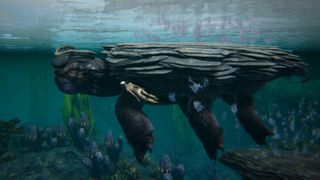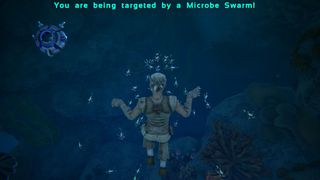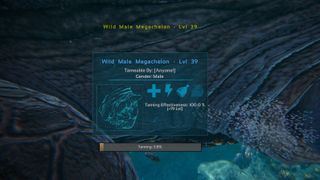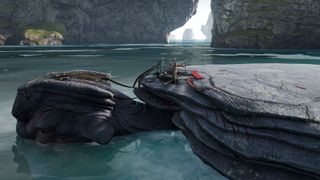How to tame Megachelon, the giant sea turtle, in Ark: Genesis
Taming this floating fortress isn't complicated, but it isn't easy, either.
If you wondering how to tame Megachelon in Ark: Genesis, it's simple, but isn't easy and can take quite a while. The giant sea turtle added in Ark's Genesis expansion is a useful pet because you can build on the back of its huge shell and use it to dive underwater while it provides you with oxygen via a breathing bubble. Of course, you'll also need a saddle to ride Megachelon, which this guide will cover further below.
Taming a Megachelon is going to happen in the water, so you'll probably want to have scuba gear with you so you don't need to worry about breathing. And while Megachelon is a passive tame, you'll want to have your best weapons with you, too. Bring some friends if possible, and if you have one, a tamed swimming dinosaur to protect the turtle from taking damage from other dinos during the taming process.
Where to find Megachelon

You'll find Megachelon in the new ocean biome in Ark: Genesis, which you can teleport to using HLNA, your AI companion. You may have to search the waters for a bit, but when one spawns they're easy to spot due to their size. They swim very slowly and occasionally breach the surface with their massive shells.
How to tame Megachelon
Once you've found a Megachelon you want to tame, swim deep down into the ocean. Megachelon is a passive tame, which means you don't need to knock it out, you just need to bring it some food it likes. And what it likes is a microbe swarm—a school of aggressive fish.

You'll be able to spot the microbe swarm: they're small but very shiny fish, they cluster together in a circle, and can be easily seen even in dark waters. And they'll spot you, too, swarming around you when you get close (you'll get a notification when they've targeted you). Once you've got their attention, start swimming back up to the surface where the Megachelon is. Make sure the swarm is following you by stopping and treading water occasionally.
Once you've lured the microbe swarm back to the Megachelon, they'll leave you alone and swim around the huge turtle instead. As you swim beside the Megachelon, you'll see the taming process has begun—though you can't see the progress bar if you're standing on its shell so you'll have to swim around near its legs or under its body.
You'll also notice from the progress bar that the tame is happening very, very slowly.
The biggest gaming news, reviews and hardware deals
Keep up to date with the most important stories and the best deals, as picked by the PC Gamer team.

The most important factor now is that you protect the Megachelon from taking damage while the lengthy taming process is underway. If it's hurt by a shark or any other creature, the taming meter will reset back to zero, which is immensely frustrating. So stick close by to watch for enemies and take them out immediately—this is why having another tamed swimming dino or some friends with you will be a huge help. Protect the turtle at all costs!
When the taming meter is full, you'll be able to name the Megachelon and have it follow you.
How to craft the Megachelon saddle

The engram for the Megachelon platform saddle will cost you 35 engram points to learn. It will need to be crafted at a Smithy, and the crafting requirements are as follows:
- Cementing paste: 28
- Fiber: 260
- Hide: 312
- Metal ingot: 76
- Shell fragment: 22
- Silica pearls: 42
Shell fragment is the only new ingredient added in Genesis for this saddle, and as you might guess, you acquire shell fragments from the Megachelon itself. So in addition to taming one, you've got to kill one (or at least loot the corpse of one that's been killed by something else). Once you've crafted the Megachelon saddle, just get close to your new pet and equip it to begin riding and building structures on it.

Chris started playing PC games in the 1980s, started writing about them in the early 2000s, and (finally) started getting paid to write about them in the late 2000s. Following a few years as a regular freelancer, PC Gamer hired him in 2014, probably so he'd stop emailing them asking for more work. Chris has a love-hate relationship with survival games and an unhealthy fascination with the inner lives of NPCs. He's also a fan of offbeat simulation games, mods, and ignoring storylines in RPGs so he can make up his own.
Most Popular


